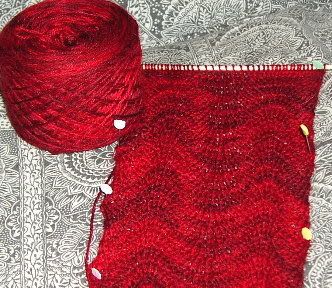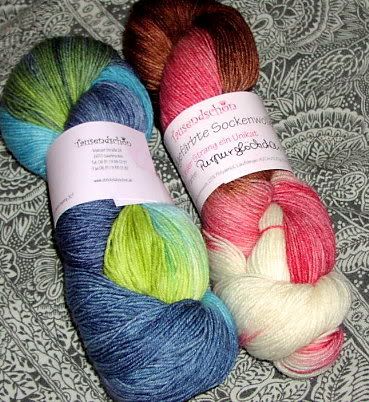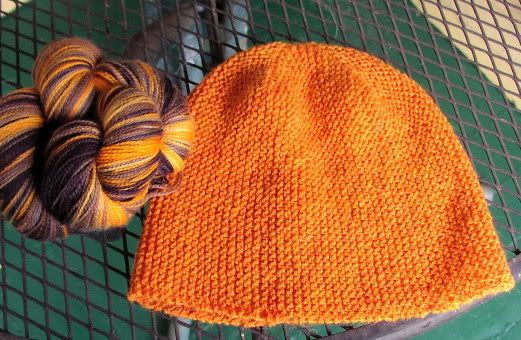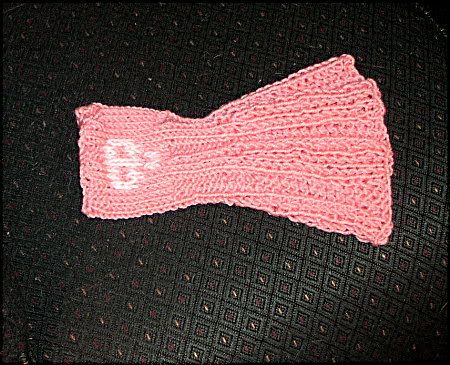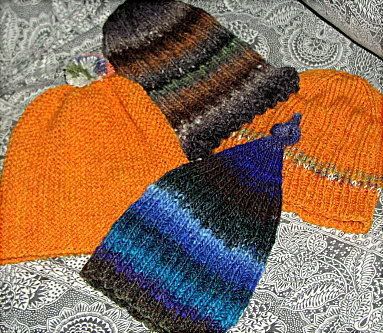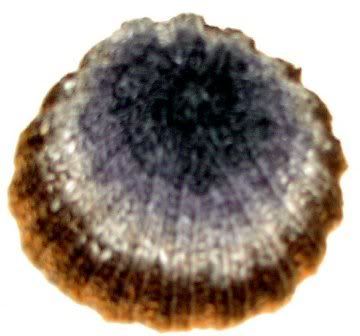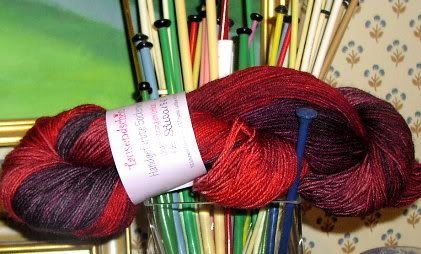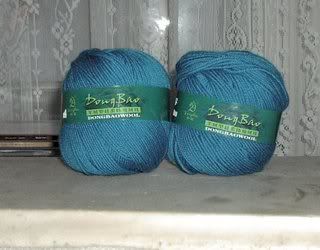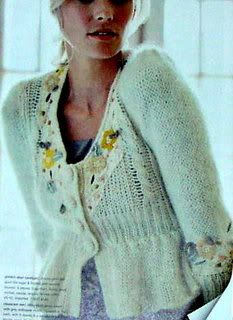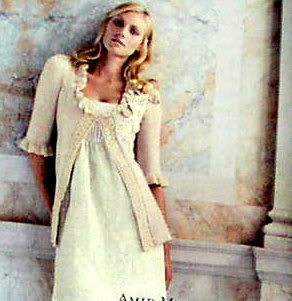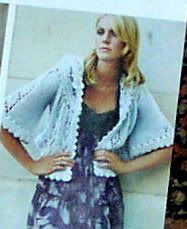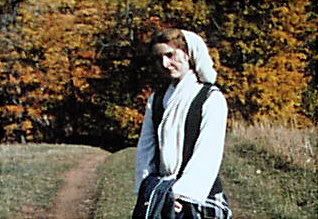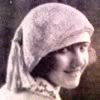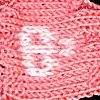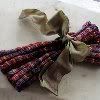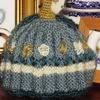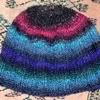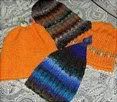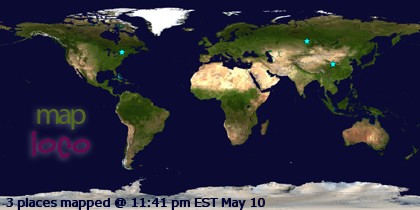Break time has finally come around here at this ancient brick educational edifice, and break time means Tea! and Knit Blogs! and even Ravelry! It is a dark and cold rain day here. Before the bright autumn leaves have even had a chance to flaunt their colour, this rain will have them down to wash away in puddles...But the colours of dyed yarns on knit blogs are even brighter than maple leaves, so that has cheered me up.
I've been wrestling with a few vintage patterns that I want to make up. Charming as they are, it does take some time and thought to gauge them with modern yarns and update the sillouettes. I like my sweaters long and slightly fitted, with longer, 3/4 length sleeves. Puff sleeves are not for me (unless they are on Dotted Swiss blouses). Soon I'll have this sweater in good shape:
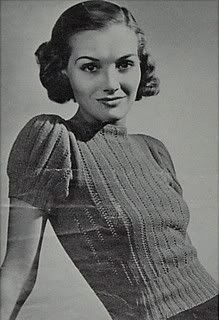
I want to make this in Debbie Bliss Cashmerino Baby. The vintage sweater yarns were often fingering weight and that means that we now can use almost any sock yarn for these patterns from the early 1900's - if we're willing to do all that knitting on small needles! This particular pattern takes a US size 5.
Another one in this same 1937 vintage booklet might lend itself charmingly to some updating:
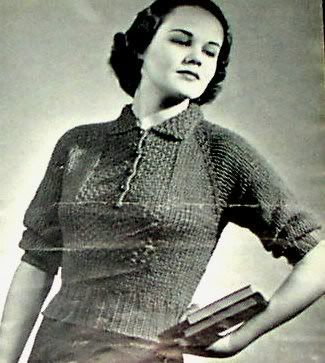
Its made with a bulky yarn - and my current favorite is the Plymouth Alpaca Grande. This would work up into a very soft, drapey, quickly knit winter sweater.
The next old booklet to get some re-design attention will be the 1920 one with the four vintage knitted bras in it!
and here it is!
The Daliet Blouse from Jack Frost Sweaters - pattern 75 years old
directions from www.unravelingsophia.blogspot.com
 “Feel correctly dressed for any occasion!”
“Feel correctly dressed for any occasion!”
Size 14 (32 bust)
Materials:
Straight needles US 2, 14” long and Straight needles US 5, 14” long
8 oz Fingering wool
[Grams to ounces conversion chart here: http://www.metric-conversions.org/weight/grams-to-ounces.htm ]
Pattern: A multiple of 7
Row 1 - *K5, K2tog, YO, repeat from *, ending K7
Row 2 – P5, P2tog, YO, repeat from *, ending P7
Front:
With No. 2 needles, CO 102 sts. K2, P2 for 4 in. Change to No. 5 needles, increasing to 112 stitches at even intervals across the row. Work in pattern for 7.5 inches from ribbing. Keeping pattern, bind of 7 sts at the beginning of each of the next 2 rows, then K2 sts tog at each end of every other row 7 times. Work 7.5 inches even. Bind off.
Back:
With No. 2 needles CO 102 stitches. K2, P2 for 4 in. Change to No. 5 needles, increasing to 105 stitches at even intervals across row. Work to correspond with front. Bind off for underarm same as front. Work armhole same as front. Bind off.
Sew shoulder seams.
Sleeves:
With No. 5 needles, on right side of blouse, pick up 35 sts across shoulder. Work back, increasing to 70 stitches. Pick up 7 sts. Continue working back and forth in Pattern, picking up 7 stitches at end of each row until 126 stitches have been picked up from end to end of armhole. Work 5 inches even. Change to No. 2 needles, decreasing to 62 sts. K2, P2, for 2 inches. Bind off.
Sew underarm and sleeve seams.
~~~~~~~~~~~~~~~~~~~~~~~~~~~~~~~~~~~~~~~~~~~~~~~~~~~~~~~~~~~~~~~~~~~~~~
Updated (modern) Instructions:
There’s no reason why you couldn’t knit this blouse on a circular needle in the round and avoid a lot of seaming. This is how I plan to do it, eliminating the tight waist and the puffed sleeves and making the blouse long and slim but still form-fitting. I may lengthen the sleeves, too.
Size 32 bust
Note: This pattern could be altered for larger sizes with a few changes:
Add 14 stitches per bust size to the cast on (this assumes a 7 st per inch gauge) . Add length by knitting extra rows in the body of the sweater. Increase the depth of the armhole scythe by working additions rows with K2tog every other row.
If you prefer a looser waist silhouette, add stitches to the cast on, in multiples of 7 per inch to be increased, and gradually decrease as you move towards the bustline.
Materials:
Circular needles US 5, 14” long and 16” long. Size 2 circular 16” for sleeve cuff (optional).
Stitch holders
5 balls (for the smallest size) Debbie Bliss Cashmerino Baby 55% merino wool, 33% Microfibre, 12% Cashmere approx. 137 yards/ 125m per 50g
Pattern: A multiple of 7
Row 1 - *K5, K2tog, YO, repeat from *, ending K7
Row 2 – Repeat
Front and Back:
With No. 5 needles, CO 224 sts. Join in round. K2, P2 for 4 in. Work in pattern for 7.5 inches from ribbing. Slip half of the stitches onto a stitch-holder. On live stitches, and keeping in pattern, bind off 7 sts at the beginning of each of the next 2 rows, then K2 sts tog at each end of every other row 7 times. Work 7.5 inches even. Bind off. [I think binding off is the best way to go to get the neck to look the way it does in the original picture]. Slip circular needle through the held stitches of the back. Repeat the instruction for the front.
Shoulder seams: seam shoulders using a fairly loose whip stitch.
Sleeves:
With 16” No. 5 circular needles, on right side of blouse, pick up 35 sts around shoulder (this should be a complete circle after seaming the shoulders). Work around even for 5 rows, establishing pattern as in front and back. Increase slightly by adding 1 stitch at beginning of pattern on 6th row, as in: K6, K2tog, YO, repeat from *, ending K7.
Work 5 inches even for short sleeves. For ¾ length sleeves, Knit until sleeve measures approximately 12 inches from shoulder.
Cuff: Change to No. 2 needles. K2, P2, for 2 inches. Bind off in rib pattern or use sewn bind-off.
© 2007 Unraveling Sophia for Silver-Apples Designs; all rights retained by author. This pattern may not be duplicated in any form, including electronic, and may not be re-posted on the internet, without express permission from the author. Links to this original pattern may be posted. It may not be included in any collection of patterns, for sale, without individual and written permission from the author. One hard copy may be retained for personal, non-commercial use. For use in charity or teaching purposes, please contact the author.

